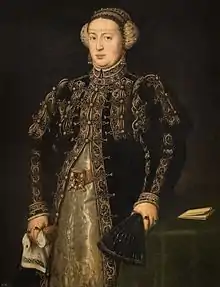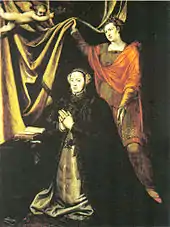Catherine of Austria, Queen of Portugal
Catherine of Austria (Portuguese: Catarina; 14 January 1507 – 12 February 1578) was Queen of Portugal as wife of King John III, and regent during the minority of her grandson, King Sebastian, from 1557 until 1562.
| Catherine | |
|---|---|
 Portrait by Anthonis Mor, 1552 | |
| Queen consort of Portugal | |
| Tenure | 10 February 1525 – 11 June 1557 |
| Born | 14 January 1507 Torquemada, Crown of Castile |
| Died | 12 February 1578 (aged 71) Ribeira Palace, Lisbon, Kingdom of Portugal |
| Burial | |
| Spouse | |
| Issue among others... | Maria Manuela, Princess of Asturias João Manuel, Prince of Portugal |
| House | Habsburg |
| Father | Philip I of Castile |
| Mother | Joanna I of Castile |
| Religion | Roman Catholicism |
| Signature |  |
Early life

An Infanta of Castile and Archduchess of Austria, Catherine was the posthumous daughter of King Philip I by Queen Joanna of Castile.[1] Catherine was born in Torquemada and named in honor of her maternal aunt, Catherine of Aragon. She remained with her mentally unstable mother until her eldest siblings, Eleanor and the future Emperor Charles V, arrived in Spain, coming from Flanders.
All of her five older siblings, except Ferdinand, were born in the Low Countries and had been put into the care of their aunt Margaret of Austria, but Joanna kept hold of young Catherine. Catherine actually stayed with her mother during imprisonment at Tordesillas during her grandfather Ferdinand of Aragon's time as regent. When the time came for her to marry, Catherine was released from the custody that her mother was to endure until her death.
Queen
On 10 February 1525, Catherine married her first cousin, King John III of Portugal. They had nine children, but only two survived early childhood.
Catherine was very concerned about the education of her family, accumulating a substantial library and establishing a kind of salon in the court.[2] She brought a number of women scholars into her household, including the humanists Joana Vaz and Públia Hortênsia de Castro, and the poet Luisa Sigea de Velasco.[2][3] Vaz was responsible for tutoring Catherine's daughter, Princess Maria, as well as Catherine's niece, also called Maria, and a scholar in her own right.[2][4]
After the death of her husband in 1557, she was challenged by her daughter-in-law and niece, Joan of Austria, over the role of regent for her grandchild, the infant King Sebastian. Mediation by Charles V resolved the issue in favour of his sister Catherine over his daughter Joan, who was needed in Spain in the absence of Philip II.
She then served as the regent of Portugal from 1557 until 1562. In 1562, she turned over the regency to Henry of Portugal.
Collector
Catherine had one of the earliest and finest Chinese porcelain collections in Europe due to her position as both the youngest sister of Emperor Charles V and the Queen of Portugal. "She acquired quantities of porcelain and exotica from Asia, which arrived regularly in Lisbon for the decoration of the Lisbon royal palace as well as for her personal use, and which served as emblems of her power. Her collection became the first kunstkammer on the Iberian Peninsula."[5] She was following a tradition established earlier by the Portuguese King Manuel I of Portugal who had purchased porcelain for his wife, Maria of Castile (1482-1517), who was Catherine's aunt. Between 1511 and 1514, the 'Treasurer of the Spices' in Lisbon "registered a total of 692 pieces of porcelain and other exotic goods" bought on his behalf for Maria of Castile, who was then King Manuel's second wife.[6] Amongst other 'exotica' in Catherine's collection were fossilised sharks' teeth, a snake's head encased in gold, heart-shaped jasper stones to stop bleeding, a coral branch used as a protector against evil spirits, bezoar stones, a unicorn's horn (a narwhal tusk) and piles of loose gems and stones such as rubies, emeralds, and diamonds.[7]
Issue
| Name | Birth | Death | Notes |
|---|---|---|---|
| With John III, King of Portugal (married 10 February 1525) | |||
| Prince Afonso | 24 February 1526 | 12 April 1526 | Prince of Portugal (1526). |
| Princess Maria Manuela | 15 October 1527 | 12 July 1545 | Princess of Portugal (1527–1531). First wife of King Philip II of Spain. She had one child, Don Carlos, and died four days after his birth. |
| Infanta Isabella | 28 April 1529 | 22 May 1530 | |
| Infanta Beatrice | 15 February 1530 | 16 March 1530 | |
| Prince Manuel | 1 November 1531 | 14 April 1537 | Prince of Portugal (1531–1537). Declared heir in 1531. |
| Prince Philip | 25 March 1533 | 29 April 1539 | Prince of Portugal (1537–1539). Declared heir in 1537. |
| Infante Denis | 6 April 1535 | 1 January 1537 | |
| Prince João Manuel | 3 June 1537 | 2 January 1554 | Prince of Portugal (1539–1554). Declared heir in 1539. Married Joan of Spain. Their son Sebastian became king. |
| Infante Anthony | 9 March 1539 | 20 January 1540 | |
Catherine has no descendants today, as both her grandchildren died childless. Her line of descent became extinct within six months of her death, as the only descendant of hers that survived her, King Sebastian of Portugal, died in August 1578.
In Popular Culture
Catherine of Austria figures in José Saramago's 2008 novel The Elephant's Journey.
Ancestry
| Ancestors of Catherine of Austria |
|---|
Sources
- Jordan, Annemarie (1994). The Development of Catherine of Austria's Collection in the Queen's Household: Its Character and Cost. Providence, R. I.: Brown University. p. 700.
- Walsby, Malcolm; Constantinidou, Natasha (2013). Documenting the Early Modern Book World: Inventories and Catalogues in Manuscript and Print. Brill. pp. 101–103. ISBN 9789004258907.
- Wyles, Rosie; Hall, Edith (2016). Women Classical Scholars: Unsealing the Fountain from the Renaissance to Jacqueline de Romilly. Oxford University Press. pp. 58–59. ISBN 9780191038297.
- Boxer, Charles Ralph (1981). João de Barros: Portuguese Humanist and Historian of Asia. Concept Publishing Company. pp. 17–18.
- Teresa Canepa, "The Iberian royal courts of Lisbon and Madrid, and their role in spreading a taste for Chinese porcelain in 16th century Europe" in Chinese and Japanese Porcelain for the Dutch Golden Age, Jan van Campen and Titus Eliens, ads. Amsterdam: Wanders Uitgevers,, n.d., p. 18
- Teresa Canepa, "The Iberian royal courts of Lisbon and Madrid, and their role in spreading a taste for Chinese porcelain in 16th-century Europe", Ibid, p. 17
- Annemarie Jordan Gshwend, "In the Tradition of Princely Collections: Curiosities and Exotica in the Kunstkammer of Catherine of Austria," in Bulletin of the Society for Renaissance Studies, Volume XIII, Number 1 (October 1995), p. 142
- Chisholm, Hugh, ed. (1911). . Encyclopædia Britannica. 11 (11th ed.). Cambridge University Press.
- Holland, Arthur William (1911). . In Chisholm, Hugh (ed.). Encyclopædia Britannica. 17 (11th ed.). Cambridge University Press.
- Urban, William (2003). Tannenberg and After. Chicago: Lithuanian Research and Studies Center. p. 191. ISBN 0-929700-25-2.
- Wurzbach, Constantin, von, ed. (1861). . Biographisches Lexikon des Kaiserthums Oesterreich [Biographical Encyclopedia of the Austrian Empire] (in German). 7. p. 112 – via Wikisource.
- Stephens, Henry Morse (1903). The story of Portugal. G.P. Putnam's Sons. p. 139. Retrieved 11 July 2018.
- Poupardin, René (1911). . In Chisholm, Hugh (ed.). Encyclopædia Britannica. 5 (11th ed.). Cambridge University Press.
- Kiening, Christian (1994). "Rhétorique de la perte. L'exemple de la mort d'Isabelle de Bourbon (1465)". Médiévales (in French). 13 (27): 15–24. doi:10.3406/medi.1994.1307.
- Chisholm, Hugh, ed. (1911). . Encyclopædia Britannica. 15 (11th ed.). Cambridge University Press.
- Chisholm, Hugh, ed. (1911). . Encyclopædia Britannica. 10 (11th ed.). Cambridge University Press.
- Chisholm, Hugh, ed. (1911). . Encyclopædia Britannica. 15 (11th ed.). Cambridge University Press.
- Ortega Gato, Esteban (1999). "Los Enríquez, Almirantes de Castilla" (PDF). Publicaciones de la Institución "Tello Téllez de Meneses" (in Spanish). 70: 42. ISSN 0210-7317.
- Chisholm, Hugh, ed. (1911). . Encyclopædia Britannica. 15 (11th ed.). Cambridge University Press.
- Chisholm, Hugh, ed. (1911). . Encyclopædia Britannica. 14 (11th ed.). Cambridge University Press.
- Downey, Kirstin (November 2015). Isabella: The Warrior Queen. Knopf Doubleday Publishing Group. p. 28. ISBN 9780307742162. Retrieved 17 July 2018.
| Wikimedia Commons has media related to Catherine of Habsburg. |
| Preceded by Eleanor of Austria |
Queen consort of Portugal 10 February 1525 – 11 June 1557 |
Succeeded by Anna of Austria |
| Preceded by Infante Peter in 1448 |
Regent of Portugal and the Algarves 11 June 1557 – 23 December 1562 |
Succeeded by Infante Henry |